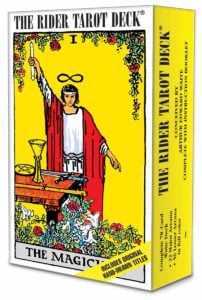Short Answer
One of the first questions new students ask is, “What’s the best tarot deck to start with?”
The choice of a first deck can be an important one. It sets the stage for our first adventures in the world of tarot. As we’ll discuss below, there’s a good argument to be made for learning tarot with the classic Rider-Waite tarot deck. But the choice is a personal one and is up to each student themselves.
Is Rider Waite the best tarot deck for beginners?
The first reason to consider Rider Waite, is that it’s the most popular tarot deck in history. (The deck is also sometimes called the “Waite Smith” or the “Rider Waite Smith” to give credit to the deck’s artist, Pamela Colman Smith who created the deck in 1909.)
There are simply no other decks which come close to the widespread adoption of Rider Waite.
Does that mean you should use it too?
Certainly there are hundreds of beautiful, modern card sets available today. Many of them are filled with evocative imagery and brilliant re-imaginings of the conventional symbolism. When selecting our first tarot deck, many of these stunning newer options can be hard to say no to.
The truth is, the best deck for you is the one you feel most comfortable with. Choose whichever one makes you happy.
Keep in mind though, that most tarot readers have dozens of decks on their bookshelves, and they go back-and-forth between them regularly. It’s not like your first deck is going to be your only deck.
virtually all other tarot decks “tip the hat” to Rider Waite’s iconic symbolism in one way or another.
If you’re serious about learning tarot, there are good reasons to start with Rider Waite.
Why? Because virtually all other tarot decks “tip the hat” to Rider Waite’s iconic symbolism in one way or another. It was Pamela Colman Smith’s seminal 1908 artwork that defined much of the visual language of tarot, and her visual symbols echo through countless other tarot decks today.
As A.E. Waite, co-creator of the deck, said in accompanying volume, A Pictorial Key to the Tarot, “The true Tarot is symbolism; it speaks no other language and offers no other signs”
If you’re serious about learning tarot, then you’re serious about learning symbols. And the symbols start here.
Rider Waite’s (nearly) universal symbolism
When tarot readers discuss the practice and philosophy of tarot, they will often make references to its visual language. You’ll hear tarot experts discuss the “red feather“, or the “hermit’s lamp“. You’ll hear debates about the “white flower” and the “Fool’s dog“. There’s even an amazing theory about a certain snail.
Many of these concepts carry through to other decks — but those references are often very subtle in modern decks, or the images have been abstracted away to the point of being unrecognizable to all but the experienced reader.
For students, these abstractions can be very confusing. For example, it would be very hard to understand the concept of the “red feather” on a deck where the feather was blue, and had been replaced by a salamander. And while that artist’s re-conception might be both beautiful and philosophically valid — it’s a good idea to start learning tarot with the same visual language as millions of other tarot readers, and move on from there.
Of course, if you want to start learning tarot with a more modern tarot deck, then the choice is yours. If you ever come across a visual reference that doesn’t make sense with your modern deck, there are excellent tarot resources available online to look up any tarot card.
Can you learn tarot with an old tarot deck?
Finally, many tarot students ask: “What about older tarot decks?” After all, the Rider Waite deck was not the first. There are decks dating back deep into the middle ages.
The short answer is, “Yes”. But learning on an older deck is likely to be a very frustrating experience because many older decks have non-standard numbers of cards, and don’t use the same imagery.
Rider Waite Smith was the first deck to incorporate detailed allegorical imagery into the Minor Arcana cards. In most older decks, the Minor Arcana cards more closely resemble playing cards. In other words, if you’re trying to learn tarot imagery, older tarot decks have much less of it than even modern minimalist decks do.
The second reason is that many older decks are considered non-standard by today’s 78-card tarot definitions. There are older decks with fewer cards like the Tarot de Marseilles. And there are decks with many more cards, like one Visconti Sforza deck that has 18 cards in each minor arcana suit.
The choice is yours
The choice of which tarot deck to start with is ultimately up to you. If a deck calls to you, then make it yours and learn from there. Keep in mind however, that you’ll be reading and hearing references to Rider Waite cards for years to come. It’s always a good idea to learn the basic visual language from this cornerstone of modern tarot.
If you do opt for a beautiful modern deck, you can always practice reading the more traditional imagery online with a free tarot reading.




